Gosh, do I love spiders…
It seems a bit unfortunate to be born a spider – they’re not well liked and generally made to feel unwelcome.
I do appreciate their appearance can be off-putting - with glistening eyes, bulbous bodies, and hairy legs. Yet, they play such a variety of important roles in the ecosystem.
Before I became a gardener, I wasn’t so fond of spiders. However, after years of working alongside them, I’ve come to really appreciate their value. Evolutionarily, they’re all so different and I am full of awe for their ability to create and design silken webs, hardwired into their DNA.
There are over 50,000 species of spiders on planet earth and 670 species living in the UK and 20% of our spiders are under threat and are critically endangered.



Why Are Spiders An Important Part Of The Ecosystem?
Natural Pest Control - They either build webs or hunt on foot (specifically the wolf spider) to catch flying insects - generally flies, aphids, beetles, mosquitoes, wasps and sadly, bee.
They help keep flying pest populations under control. A single spider can eat hundreds of insects per year - we shouldn’t need chemical pesticides if we are encouraging them in the garden.
Balancing the Ecosystem - They help regulate insect populations, preventing any one species from dominating and damaging plants.
Indicators of a Healthy Garden -It’s a sign that your garden is a well-balanced environment, spiders are very sensitive to chemicals so will depart at the sign of any toxic spray bottle.
Spider Webs and Techniques
Spider silk is a protein-based material made primarily of fibroin, a fibrous protein, produced in specialised silk glands in a spider’s abdomen. The silk is extruded through structures called spinnerets.
You might think of a spider’s web as something delicate, but it’s actually made from a remarkably strong material, silk.
The spider uses this silk to create everything from the frame of its web to sticky threads for catching prey. Though it looks fragile, it’s stronger than steel when compared by weight.
Ballooning - I expect you’ve had a money spider crawling on you at some point. This is usually due to ballooning - when a spider releases silk threads into the wind, allowing it to travel huge distances to find a new home. When a spider lands on you, it means you’ve just intercepted one of its aerial dispersal journeys!
The spider will appear as if it’s flying. Of course, the silk isn’t visible to your eye, but the spider’s intention is for the silk to catch the wind and carry it to an exciting new home. Take a look at the crab spider ‘balloning’:
Bridging gaps - Next up is how some spiders, like orb-weavers, use silk to bridge gaps. They cast a silk line, a bit like a fisherman casting a fishing line or Peter Parker’s web equivalent in Spider-Man. This silk helps the spider cross from one spot to another and begin building its web.
Spider Vision
Most spiders have eight eyes, which tend to be arranged into two rows of four eyes on the head region.
Yet, they don’t always have good vision, for example: the house spider and the orb weaver - relying more on touch and vibration in their webs to sense what’s going on around them.
Others, like wolf spiders and jumping spiders, have excellent vision. Jumping spiders in particular have large front eyes that give them sharp, colour vision and even depth perception – useful for stalking and pouncing on prey.
So while all those eyes may seem like a little too many eyes, different spiders use them in different ways depending on how they hunt and where they live.
Understanding How Spiders Use Body Language
A spider will flatten itself against a surface if it’s frightened, however generally will stay perfectly still - hoping they haven’t been spotted.
One of my favourite spiders is the crab spider, and when threatened, it stretches its front legs out wide and lifts its body slightly. It does this to appear larger and more intimidating.
A Few Of London’s Most Spotted Garden Spiders & Some Interesting Identifying Facts About Them
European Garden Spider or Cross Orb - Weaver - Araneus diadematus

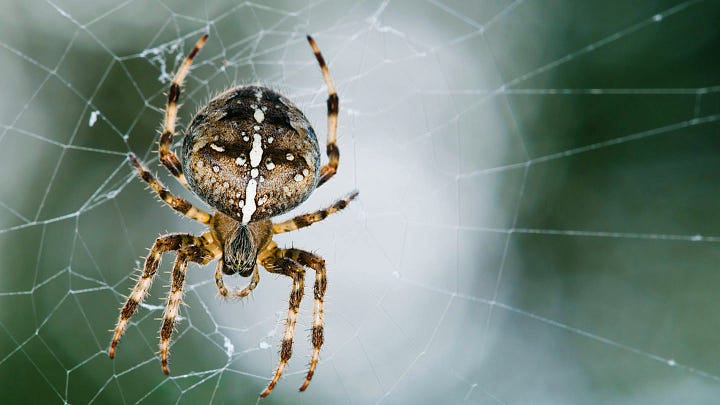
These are most common in late summer (around September), spinning a fresh web each day. They’ll eat their old web in a process called ‘dismantling’ to recycle the silk proteins and save energy - making silk is incredibly energy intensive.
It can be risky business if you’re a male garden spider, as occasionally the female will eat the male after mating.
🕸️
Missing Sector Orb Weaver or Window Spider - Zygiella x-notata'
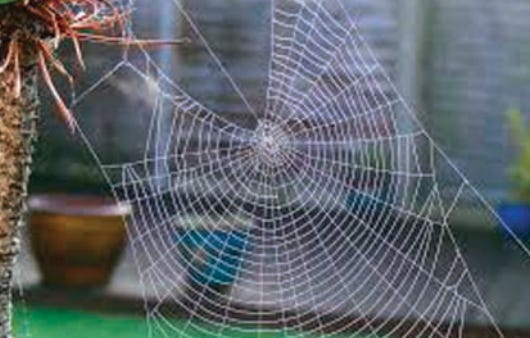

These look quite similar to the false widow spider, but on close inspection they’re very different - they have a leaf-shaped mark on their back, shaped a little like the common oak leaf.
Their webs are made with neat circles, but there’s always a section missing - hence the name.They like to make their webs on windows and often on car wing mirrors.
🕸️
Crab spider - Misumena vatia
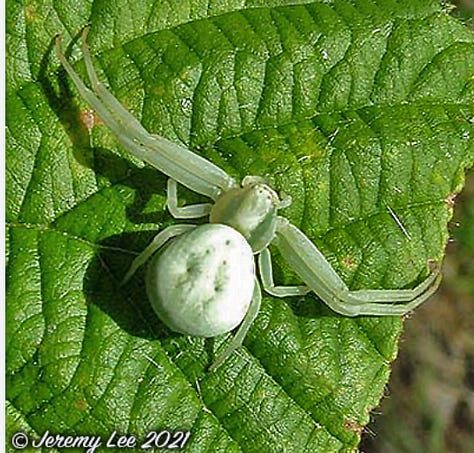


My favourite spider…. often found sitting still on large open flowers like roses, daisies or rudbeckia. They wait patiently for unsuspecting pollinators like bees, flies or butterflies to land nearby.
Crab spiders don’t spin webs to catch prey. Instead, they rely on camouflage and quick reflexes. Their body shape and sideways scuttling movements are similar to crabs so you understand how it earned their name.
The females can change colour over a few days to better match the flower they’re hiding on, from white to yellow and sometimes even pink, helping them stay hidden in plain sight.
🕸️
Nursery Web Spider -Pisaura mirabilis
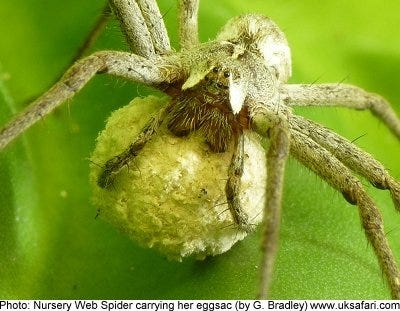
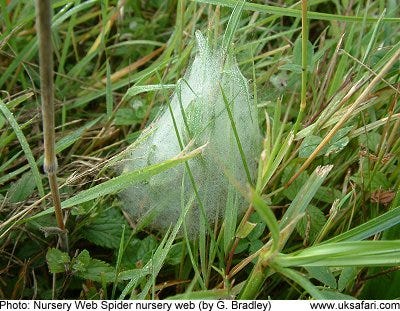
This spider used to fascinate me as a child. It’s commonly seen running around the garden carrying their egg sac in its jaws.

The spider is light brown with a pale stripe down its back.
They can be found hiding in the undergrowth or enjoy lurking around brambles and stinging nettles.
They hunt by foot, instead their webs are used to protect their young and lay eggs.
Like the garden spider, mating can be dangerous for the males. During mating season, the male spider will pretend to be dead, remaining still so when the female approaches to eat, he can catch her by surprise and mate. It’s tricky business and, if he isn’t quick enough, he becomes supper fairly quickly.
🕸️
Wolf Spiders - Pardosa species
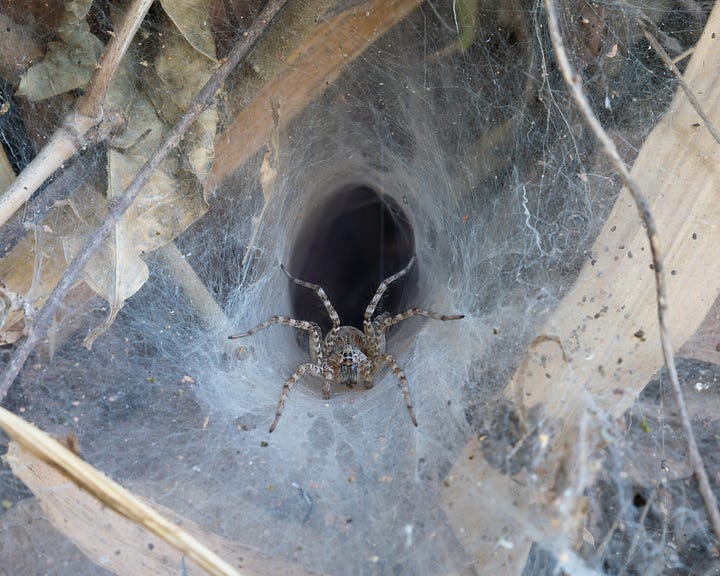

Similar in appearance and behaviour to the nursery web spider, wolf spiders hunt on foot, catching prey by leaping like a wolf, hence their name. They can often be spotted sunbathing in the garden.
The female carries her young on her abdomen once they hatch - the tiny spiders cling tightly to her hairs and ride on her back for a few weeks until they can live independently. If you look at the photo above, on the right, you can see the tiny spider babies riding on the back.
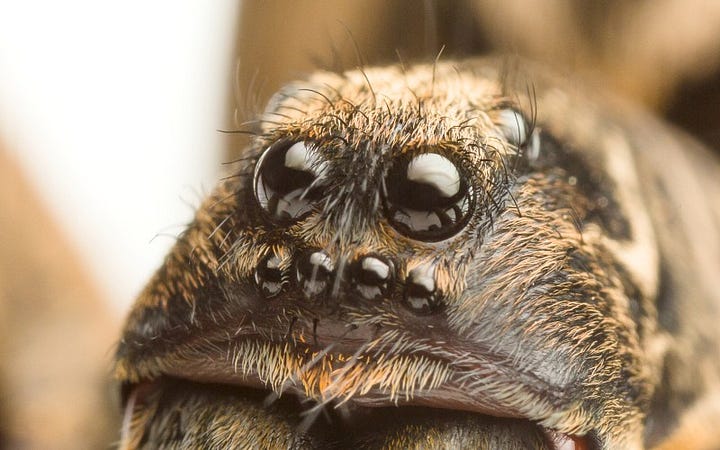
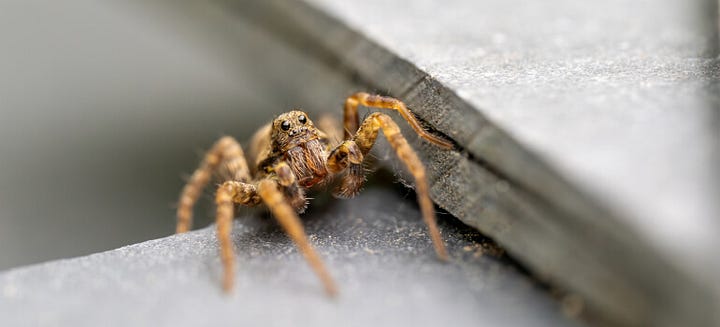
They have incredibly good vision with 360 degrees awareness:
two small eyes on the top row (for sharp vision)
two large eyes (for hunting and depth perception)
four small eyes on the bottom row (for detecting motion and giving them a wide field of view)
They need such good eyesight to chase and ambush prey. They also have night vision - their large middle eyes reflect light, allowing them to see in low light, much like cats’ eyes shining in the dark.
🕸️
Money Spider - Linyphiidae
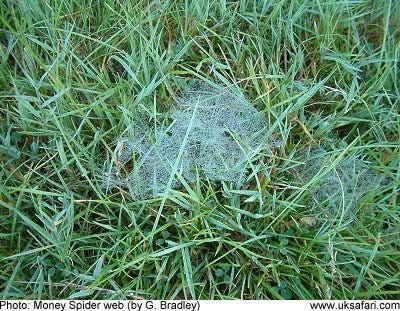

These are the cutest little spiders and, to me, always a symbol of monetary success coming your way. Of course, it’s bad luck to brush off a money spider.
They make small sheet webs in grass and shrubs to catch prey. Their webs aren’t sticky like others; instead, the prey falls through and becomes tangled. Their typical prey are aphids.
🕸️
False Widow Spiders - Steatoda nobilis


I’ve worked hard to have a better relationship with the false widow spider. I’ve been bitten a few times by these naughty spiders - not much to worry about, just two little pincer marks on my skin. I’m sure I deserved it as they only bite if threatened or disturbed.
The false widow is the only spider in the UK that plays dead. It has a skull-like shape on their glossy, dimpled abdomens.
When making webs, they will build a tube which leads into a crack or hole allowing them to hide if threatened.
🕸️
Common House Spider - Tegenaria domestica / Eratigena atrica


This one is probably the most frightening spider for many. It is usually seen indoors in late summer, often the male hunting for a female so can be spotted sometimes moving along the walls.
House spiders generally have poor eyesight and rely on vibrations in their webs to detect prey. Like the false widow, it creates a funnel retreat in its web so can be found inside their hideaway or resting on top of the web.
They can be found hiding in tree hollows, preferring quiet, undisturbed spots for their webs.
🕸️
So hopefully next time you see a spider, you’ll feel less fear and appreciate how each spider has such wonderful evolutionary skills!
If you’d like a good book to read on spiders - I’d suggest this book.
Also, check out this comprehensive spider guide which can be helpful in identifying.




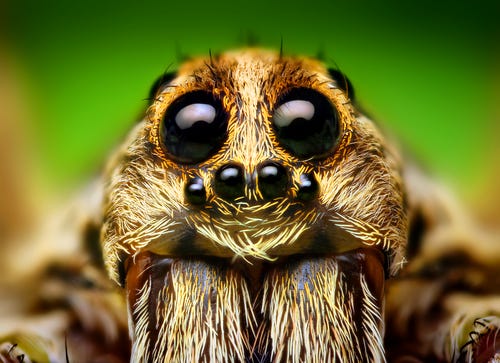
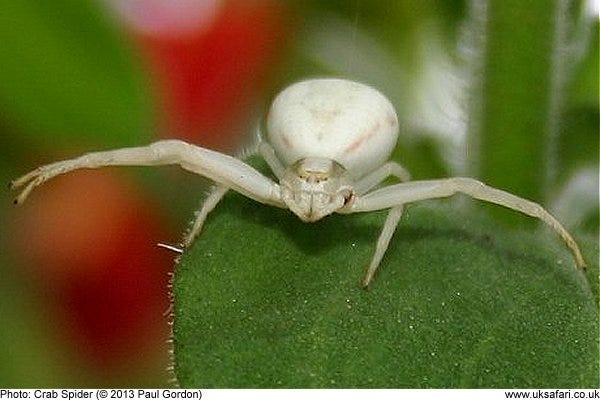
This was so interesting, thank you! I’ll be actively trying to spot the different types
now :)
Thank you for sharing all this Sarah! I'm still wildly creeped out by your little friends though 😆 hope you're doing well. Sending hugs to you and Rowan